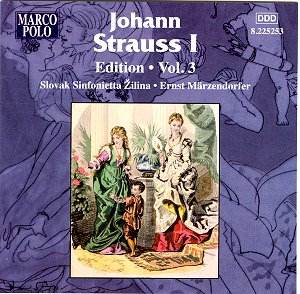The first two volumes
in this series dedicated to Johann Strauss
père were conducted by
Christian Pollack, using different orchestras.
[Volume
1, Volume
2] While I admired Pollack’s
general approach, non-interventionist
and dance-oriented, I felt that the
quality of the orchestra used for Volume
1, the Camerata Cassovia,
as well as the rather modest nature
of the very early works, limited the
issue to Strauss completists. The second
volume used the Slovak Sinfonietta Žilina
which, if not entirely beyond reproach
in matters of intonation and ensemble,
was a distinct improvement on
the Camerata Cassovia. And, while the
young composer’s inspiration was still
short-winded and not highly memorable,
he was developing an original line in
orchestration, with the result that
this volume was of rather wider interest.
Now we
have the Slovak Sinfonietta Žilina again
under a different conductor. Does this
make a difference? Yes, it definitely
does. Though general collectors may
know Ernst Märzendorfer only as the
conductor of Nicanor Zabaleta’s recordings
of harp concertos by Boieldieu,
Rodrigo, Reinecke and Mozart’s flute
and harp concerto (with the Berlin Radio
Symphony Orchestra and Berlin Philharmonic
respectively, DG discs issued in 1961
and 1963 that have been recycled and
recoupled over the years) he has in
fact had a long and distinguished career.
Born in Oberndorf, Salzburg in 1921
he studied with Clemens Krauss and became
first conductor of the Graz Opera in
1945. He was conductor of the Salzburg
Mozarteum Orchestra from 1953-1958,
became a permanent conductor of the
Vienna State Opera in 1961 and has been
a regular conductor of the Berlin State
Opera since 1964. In 1999 he was made
an Honorary Member of the Vienna State
Opera and, though officially retired,
still conducts there from time to time.
If his career sounds to have been Austro-German-based,
he has also made tours on both sides
of the Atlantic, conducting, among other
things, the first New York performance
of Richard Strauss’s Capriccio.
His repertoire is wide, stretching from
Cavalieri’s Rappresentazione di Anima
e Corpo to premières of works
by Einem and Henze, and including on
the way 20 operettas by Offenbach at
the Salzburg Festival. As a recording
artist, it seems to have been his fate
to have worked mostly for rather obscure
labels. His most significant achievement
is surely his Haydn cycle, the first
complete recording of all 107 symphonies
(yes, before Dorati), made with the
Vienna Chamber Orchestra. For contractual
reasons this never enjoyed wide circulation
and has not been transferred to CD.
Under his
experienced direction the Slovak Sinfonietta
Žilina appear transformed. Not even
he can entirely eliminate the clarinet’s
tendency to play sharp but in general
a comparison between any track on the
earlier disc and any on the present
one is rather like looking at
a newly-restored painting, so much more
refined and pointed is the playing,
so much more alive are the rhythms.
Märzendorfer’s approach is not
actually very different from Pollack’s
– he, too, is non-interventionist and
dance-oriented – he just does it so
much better. I did wonder at first if
there was not a slightly professorial
air to it – a demonstration of how to
conduct Strauss – but come the Hungarian
Galops and he certainly stirs things
up. I doubt if we can expect to hear
better performances of these particular
works and this, combined with the young
composer’s burgeoning lyricism, makes
Volume 3 an essential disc for anyone
even remotely interested in this repertoire.
Regarding Strauss himself,
Franz Mailer’s useful notes (well translated
by Keith Anderson) say of Es ist
nur ein Wien!: "… it can clearly
be heard that the period of grinding
out short motifs in triple time was
past. Certainly Johann Strauss had not
yet discovered the definitive form of
the waltz. … Nevertheless the development
of the simple dance into an art work
had begun … Perhaps it can be said the
Es ist nur ein Wien! stands at
the beginning of the spread of Austrian
music beyond national borders and to
the world." I couldn’t state more
clearly the reason why I feel this disc
is essential in the way the previous
two were not. After my rather doubtful
reaction to Volume 1 I am now hooked
and very much look forward to the continuation
of the series – and I hope Märzendorfer
will be conducting some of it.
Interestingly even
the recording, made by the same team
as the other two (Hentšel and Toperczer)
is more distanced and refined this time
– the previous efforts were almost aggressively
close.
Christopher Howell
